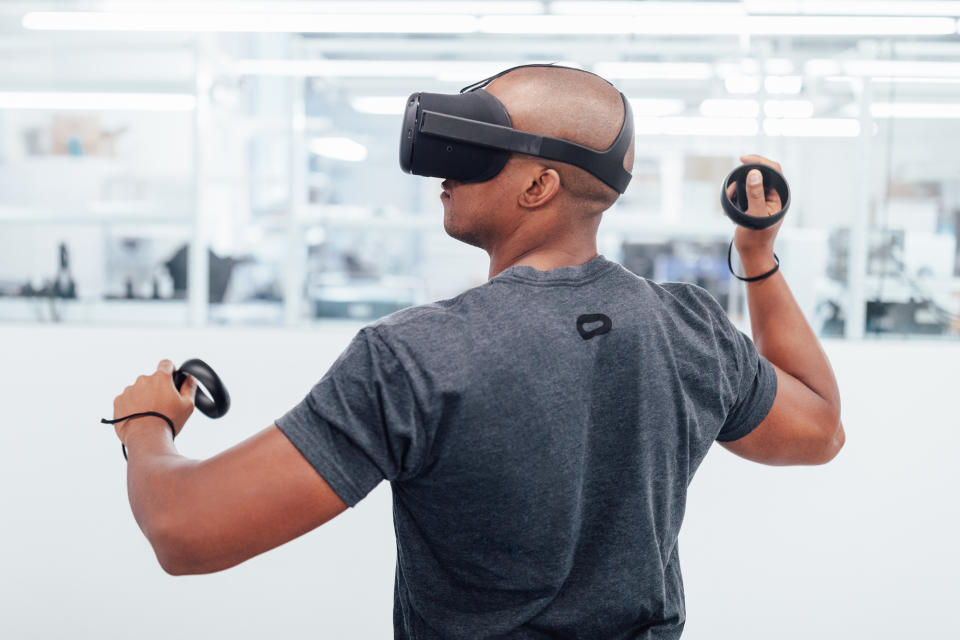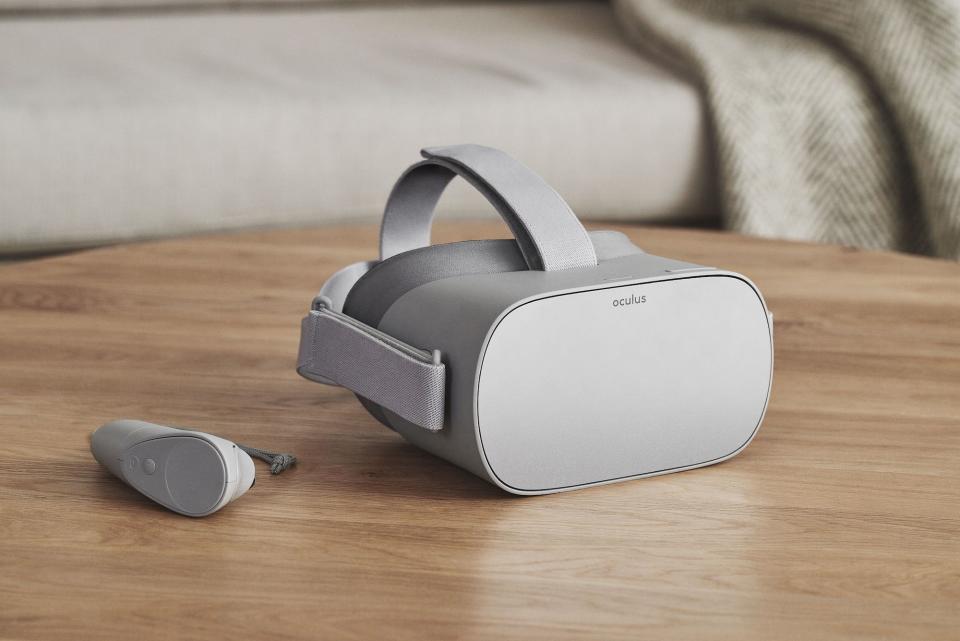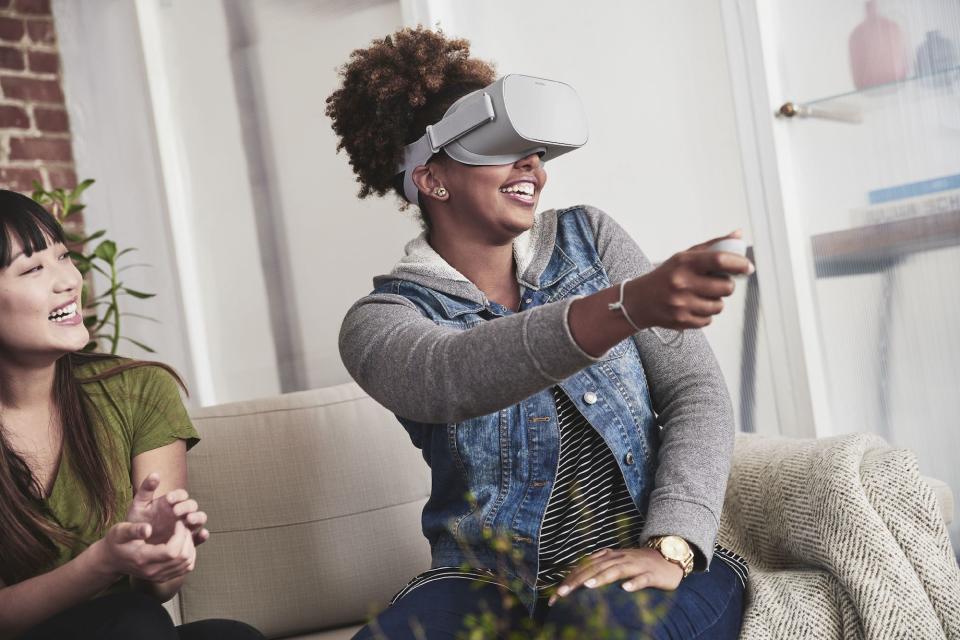Oculus' standalone headsets point to a changing VR landscape
The $199 Go is just the beginning.
Last year was the year that VR went mainstream. The Oculus Rift finally shipped to consumers, as did the HTC Vive and the PS VR. But even as the VR industry is finally starting to take off, it's already beginning to splinter. Before, we had phone-based VR like Samsung's Gear VR and Google's Daydream, and then higher-end PC models like the Rift and the Vive. Now, the standalone VR headset is emerging as a category unto itself. And it stands to make the VR landscape a lot more accessible -- and possibly more divisive -- than ever before.
The idea of standalone VR headsets is not a new one. Intel explored the field with Project Alloy for a while before killing it earlier this year, Alcatel made one that didn't quite take off and Google announced it's working with standalone Daydream headsets from HTC and Lenovo too. But it's Oculus -- the pioneer of modern VR -- that is the first to come out swinging with two different kinds of standalone VR headsets, one of which will be available to consumers early next year.
The latter is the Oculus Go, and it was the highlight of this year's keynote at Oculus Connect 4. It's attractively priced at $199 and shares the same DNA as the Gear VR -- apps for the Gear VR should be compatible with the Go. The Go features a "fast-switch LCD" with WQHD 2560x1440 resolution that's apparently better than OLEDs. It also has built-in audio, so you don't need headphones.
Will Smith, the CEO and founder of FOO VR -- a company that builds talk shows in VR -- was enthusiastic about the Go's price: "$200 is fantastic. It makes VR so much more accessible and so much more compelling." Also, as an iPhone user, he says the idea of a standalone headset is much more attractive than having to buy a Samsung phone on top of the Gear VR.
Sam Watts, a director of immersive technologies for MakeReal, a VR company based in the UK, was equally positive. "The price is just about an impulse buy," he said. "You don't need to buy a phone to use it and, as a developer, it's nice to not have to worry about the 'phone parts' of the phone interfering with the experience."
"An all-in-one untethered headset like this is the future," Watts continued. "It's a good step to wider adoption." He also likes that the Gear VR and the Go will be software-compatible -- Oculus has said the Go is also powered by Android -- so it's much easier for the same apps to work on both headsets.

Yet the Go isn't the only standalone headset Oculus is working on. It's also developing Project Santa Cruz, which is much more powerful than the Go. We had a chance to try it out at Oculus Connect 4, and the experience is much more akin to the Rift -- with 6DOF (degrees of freedom) controllers and full positional tracking. The Go, by contrast, only has a 3DOF controller and orientation tracking like the Gear VR.
It seems that standalone headsets like Santa Cruz are the future of VR; untethered yet powerful. And while Go is less capable, having a cheap VR option is good too. Phone-based and PC-tethered VR already seem like they could get outdated in the next few years. Suddenly, though, it seems that Oculus has a divisive product portfolio on its hands.
But it's early days still for VR. "Mobile drop-in, phone-based VR is going to be persistent," said John Carmack, Oculus' CTO, on the Oculus Connect 4 stage. "Standalone will probably take over and be a dominant form, but cellphone-based VR will still have the largest number of users." This, he said, is because phones will improve exponentially over time and will probably drop in price. The Galaxy Note 8 of today will probably be very affordable in the future. "A cheap phone playing VR applications will still have significant value to users. ... I don't expect Go to do Samsung-like [sales] numbers."

Watts remains enthusiastic, too. "It's great to have options," he said. "These headsets have the same ecosystem, really. The cheap option lets you take a small bite of VR, and if you like it, you can upgrade and still keep all your apps."
"My guess is that the Go and the Santa Cruz will be one headset eventually," said Smith, adding that Oculus will probably have just one standalone option in the future. Carmack seems to hint at the same, saying on stage that he thinks the two products will converge some day. Still, that'll likely take a few years. While Santa Cruz is much more capable, the cost of making it right now is just too high, Carmack said: "$199 is a superpower for Go. It's unlikely that we can throw all the other [high-end features] in at once."
Besides, Carmack says, there's still room for low-end VR. "You don't need 6DOF for watching 360-degree videos," he said, adding that Go and GearVR are for much more passive VR experiences.
Oculus won't be the only one offering all-in-one headsets. As mentioned earlier, Google is working on standalone Daydream devices with the help of HTC and Lenovo. There's room for independent companies to come forward with their own solutions. Yes, the VR landscape will shift and split. But that could be a good thing.
"As with all tech, good things come to those who wait," said Watts. "You just have to sit and be patient."

 Yahoo Finance
Yahoo Finance 











